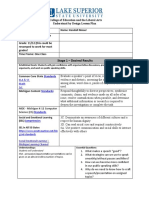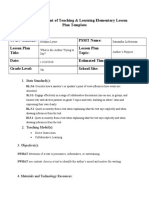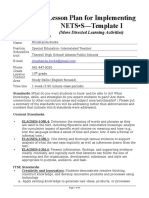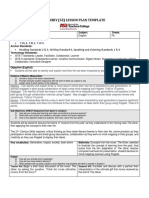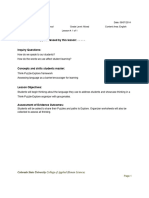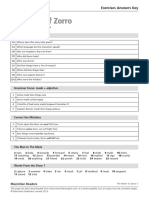Educ 450 - Id Lesson Plan 1
Educ 450 - Id Lesson Plan 1
Uploaded by
api-707646511Copyright:
Available Formats
Educ 450 - Id Lesson Plan 1
Educ 450 - Id Lesson Plan 1
Uploaded by
api-707646511Original Description:
Original Title
Copyright
Available Formats
Share this document
Did you find this document useful?
Is this content inappropriate?
Copyright:
Available Formats
Educ 450 - Id Lesson Plan 1
Educ 450 - Id Lesson Plan 1
Uploaded by
api-707646511Copyright:
Available Formats
CEP Lesson Plan Form
Teacher: Amelia Simmons Date: 13/32
School: Rocky Mountain HS Grade Level: 12 Content Area: English 12
Title: History of the N-word Lesson #: ? of ?
Identify which part of the lesson meets 1 or more of the 4 part Mission of the National Network for
Educational Renewal (Equal Access and Excellence, Stewardship, Nurturing Pedagogy and
Enculturation.): What are you and your students doing today to advance the 4-Part Mission? Does this
lesson connect to one or more parts of the Mission? Please briefly explain.
Equal Access- Students read at own pase, multiple forms of media are used, transcripts/subtitles
provided for videos.
Stewardship-
Nurturing Pedagogy-
Enculturation- Learning a not often talked about subject and history that is important to modern
understandings of race interactions and racism.
Lesson Idea/Topic and Rational/Relevance: When reading African-American Literature, the n-word is
What are you going to teach and why is this a prevalent and piercing word. There will be works
lesson important to these students? What written by African Americans that include the n-word.
has already happened in this classroom Why is this word harmful? Who gets to use the n-word?
surrounding the subject you will be Why? How did the n-word come to be? Why is it still
teaching? What do students already know? used?
Why are you going to teach this topic now
(how does it fit in the curricular sequence)?
What teaching methods/strategy will you
be use and why?
What is the key vocabulary necessary for slur
students to know in order to learn the
material? racism
Content Standard(s) addressed by this lesson: (Write Content Standards directly from the standard)
Standard 1.1 Follow collaborative guidelines to ensure a hearing of a full range of positions on a topic or
issue, and evaluate responses.
Standard 2.1 Interpret and evaluate complex literature using various critical reading strategies.
Colorado State University College of Health and Human Sciences Page 1
CEP Lesson Plan Form
Standard 2.2 Interpret and evaluate complex informational texts using various critical reading strategies.
Standard 2.3 Understand how language influences the comprehension of narrative, argumentative, and
informational texts.
Understandings: (Big Ideas)-(Learning Target) SWBAT explain why the n-word is harmful.
Inquiry Questions: (Essential questions relating knowledge at end of the unit of instruction, select
applicable questions from standard)
Why is the n-word harmful?
Evidence Outcomes: (Learning Targets) AND (Success Criteria) Next to each Learning Target OR
Objectives, state how you are addressing literacy AND numeracy within this lesson.
I can: Explain why we will never say the n-word in class.
This means: I know the history of the n-word. I know the impact the n-word has on people in my
community. I understand that the n-word should only be used by Black people if they feel comfortable to
do so.
List of Assessments: (Note whether the assessment is formative or summative?)
Reflection of reading (formative)
Colorado State University College of Health and Human Sciences Page 2
CEP Lesson Plan Form
Planned Lesson Activities
Name and Purpose of Lesson
Should be a creative title for you and the students to What is the n-word?
associate with the activity. Think of the purpose as
the mini-rationale for what you are trying to (before teaching this lesson, i will check in with my Black and brown students and explain
accomplish through this lesson. what/when this lesson is, why I am teaching it, and asking if they feel comfortable being
in the classroom that day or if they’d rather be outside that space (in the library or
similar))
Approx. Time and Materials
How long do you expect the activity to last and what 90 minute (ish) lesson
materials will you need? slideshow, printed pdfs and articles below, post-it notes, half sheets of paper
Anticipatory Set What is Biased, Offensive and Harmful Language?
The “hook” to grab students’ attention. These are 1. Begin the lesson by asking students: What is biased, hateful or offensive words or
actions and statements by the teacher to relate the language? (Turn and talk) Have some students share their thoughts aloud.
experiences of the students to the objectives of the 2. Explain that in this lesson, we will discuss slurs, which is one type of biased and
lesson, To put students into a receptive frame of offensive language. Share that we will specifically be talking about the N-word,
mind. which is a racial slur. Ask: What is a slur? (Turn and talk) Elicit and explain that a
● To focus student attention on the lesson. slur is: “an insulting, offensive or degrading remark, often based on an identity
● To create an organizing framework for the group such as race, ethnicity, religion, ethnic, gender/gender identity or sexual
ideas, principles, or information that is to orientation.”
follow (advanced organizers) [Note to Teacher: If you want to provide an anonymous option for students to share their
An anticipatory set is used any time a different thoughts about what biased language and slurs are, use notecards or Mentimeter to
activity or new concept is to be introduced. collect their thoughts rather than having students shared aloud.]
3. Ask students: Where do we see and hear slurs and other biased/offensive
language? Record their responses on the board, which could include the
following:
● Music lyrics, Movies and TV, Online/digital spaces, social media and texting,
Books/literature, Said out loud to someone to demean and insult them, Said out
loud to show connection to others in same identity group, Written out in public
or private places as a hate symbol, Private conversation we’re in or ones we
overhear, Public conversations: celebrities, comedians, politicians, other famous
people
Colorado State University College of Health and Human Sciences Page 3
CEP Lesson Plan Form
4. Ask students: What are the main qualities of a slur? How do you know something
is a slur? Students respond on distributed post-it notes; each student writes
words and phrases which they return to you to place on a wall or
board/smartboard. After capturing and sharing their responses, engage students
in a brief discussion by asking: What patterns do you see in the responses? How
would you explain the main qualities of a slur?
5. Ask students: When you see or hear slurs, what thoughts and feelings come up
for you? (Post-it notes again, anonymous as possible) As results come in and they
are shared with the class, engage students in a brief discussion by asking: What
do you notice? What do you wonder?
Procedures Students will explore the history and use of the n-word through multiple articles and
(Include a play-by-play account of what students and videos.
teacher will do from the minute they arrive to the White and Wondering Why You Can’t Use the N-Word? Watch This - CNN, video
minute they leave your classroom. Indicate the How the n-word became the atomic bomb of racial slurs - PBS, video or transcript
length of each segment of the lesson. List actual The N-word in the Classroom - TED, video
minutes.) How the n-word became unsayable - New York Times, article
Indicate whether each is: NAACP Official Position on the Use of the Word "Nigger" and the "N" Word - NAACP,
-teacher input article
-modeling The articles will be printed out and the videos will be linked in the online classroom.
-questioning strategies
-guided/unguided: Students will individually be asked to summarize and reflect on their learnings from the
-whole-class practice provided materials in some written form.
-group practice
-individual practice To wrap up learnings, the teacher will pass out half sheets of paper. The teacher will ask
-check for understanding the students if they are comfortable and willing, to write an experience they had with the
-other n-word. The teacher will also stated that they (the teacher) will read out these
experiences to keep it as anonymous as possible. If students do not have an experience
they wish to share, they will be asked to write to the prompt: how would you react to a
non-black friend using the n-word while singing along to a song. (This is so those not
sharing an experience will not be writing supstancially less than those that are.)
Closure End by explaining that the n-word appears often in literature, even literature written by
Those actions or statements by a teacher that are Black people. Understanding the history and impact of the word before we read it will
designed to bring a lesson presentation to an allow our classroom community to support each other and not cause additional trauma.
Colorado State University College of Health and Human Sciences Page 4
CEP Lesson Plan Form
appropriate conclusion. Used to help students bring
things together in their own minds, to make sense Close by reminding students that while we will see the n-word or even hear it in
out of what has just been taught. “Any Questions? recordings and songs, in our classroom, we will always refer to it as the “n-word.”
No. OK, let’s move on” is not closure. Closure is used:
● To cue students to the fact that they have
arrived at an important point in the lesson or
the end of a lesson.
● To help organize student learning
To help form a coherent picture and to consolidate.
Differentiation: Reflection after reading the articles and videos:
Require fewer of the texts to read.
Differentiation should be embedded
throughout your whole lesson!! Have students specifically quote texts and breakdown the points of those quotes in their
This is to make sure you have met the reflection
needs of your students on IEPS or 504
To modify: If the activity is too advanced for a child,
how will you modify it so that they can be successful?
To extend: If the activity is too easy for a child, how
will you extend it to develop their emerging skills?
Assessment Reflection: (data analysis)
How will you know if students met the learning Students will have met the learning targets if in their reflections they acknowledge the
targets? Write a description of what you were trauma and hurt the n-word holds to people and understand why not to use it.
looking for in each assessment.
Colorado State University College of Health and Human Sciences Page 5
You might also like
- BABOK 3 ONLINE - A Guide To The Business Analysis Body of KnowledgeDocument514 pagesBABOK 3 ONLINE - A Guide To The Business Analysis Body of KnowledgeFrancisco Barrera Rodríguez98% (62)
- Sipps Systematic Instruction in Phonological Awareness Phonics and Sight WordsDocument3 pagesSipps Systematic Instruction in Phonological Awareness Phonics and Sight Wordsapi-448690566No ratings yet
- Lesson Plans Grade Nine Media StudiesDocument12 pagesLesson Plans Grade Nine Media Studiesapi-395442607No ratings yet
- SIOP Lesson Plan - Neighborhood OdesDocument4 pagesSIOP Lesson Plan - Neighborhood OdescindisolNo ratings yet
- Zones Lesson PlanDocument5 pagesZones Lesson Planapi-334767841No ratings yet
- Akia Williams Final GrplessonplanDocument3 pagesAkia Williams Final Grplessonplanapi-702838405No ratings yet
- Horror Genre Lesson PlanDocument7 pagesHorror Genre Lesson Planapi-318040073No ratings yet
- Viterbo University Lesson Plan Template Lesson One: VocabularyDocument31 pagesViterbo University Lesson Plan Template Lesson One: Vocabularyapi-449381481No ratings yet
- Cuc Lesson Plan Design 2013Document5 pagesCuc Lesson Plan Design 2013api-242257813No ratings yet
- Emma Pebley I. ContextDocument14 pagesEmma Pebley I. Contexteep5026No ratings yet
- BTS G10a TG U3Document60 pagesBTS G10a TG U3Badi Al HamadNo ratings yet
- Atss Lesson 4 - Conversation Cups-2Document6 pagesAtss Lesson 4 - Conversation Cups-2api-698236772No ratings yet
- Module-4 (Te2)Document12 pagesModule-4 (Te2)Joanne LorenzoNo ratings yet
- Sample Lesson PlansDocument6 pagesSample Lesson Plansapi-552410496No ratings yet
- Assignment Lesson Plan LauraDocument5 pagesAssignment Lesson Plan Lauraapi-333858711No ratings yet
- Semi Detailed Lesson Plan Grade 11 Oral CommDocument5 pagesSemi Detailed Lesson Plan Grade 11 Oral CommIvy Joy Labisores Postanes100% (1)
- Tuesday Lesson Plan Ela A10Document4 pagesTuesday Lesson Plan Ela A10api-345779940No ratings yet
- Lesson Plan For Patrick Henry Speech To The Virginia ConventionDocument3 pagesLesson Plan For Patrick Henry Speech To The Virginia ConventionLynn Green FoutsNo ratings yet
- Day 1Document8 pagesDay 1api-408072479No ratings yet
- French Lab Get To Know You ActivityDocument3 pagesFrench Lab Get To Know You Activityapi-273091239No ratings yet
- Moser Lesson Plan 2 Educ350Document5 pagesMoser Lesson Plan 2 Educ350api-651337707No ratings yet
- Final ProjectDocument5 pagesFinal ProjectGenoveva SagurieNo ratings yet
- Siop Lesson PlanDocument4 pagesSiop Lesson Planapi-526732984No ratings yet
- Ed615 Lesson He Lion Bruh Bear and Bruh RabbitDocument10 pagesEd615 Lesson He Lion Bruh Bear and Bruh Rabbitapi-394394249No ratings yet
- Lesson Plan: Outcomes From Alberta Program of StudiesDocument5 pagesLesson Plan: Outcomes From Alberta Program of Studiesapi-296555605No ratings yet
- LPG Lesson Plan GuideDocument6 pagesLPG Lesson Plan Guideapi-734710904No ratings yet
- Formal, Intimate, Frozen, Casual StylesDocument4 pagesFormal, Intimate, Frozen, Casual StylesCJ MarzNo ratings yet
- 5 Day Lesson PlansDocument41 pages5 Day Lesson Plansapi-407279500No ratings yet
- Of Mice and Men Day 1Document5 pagesOf Mice and Men Day 1api-252410382No ratings yet
- Mini Lesson AssignmentDocument5 pagesMini Lesson Assignmentapi-563411264No ratings yet
- Lesson Plan Recognizing AudienceDocument21 pagesLesson Plan Recognizing AudienceCPaulE33No ratings yet
- Lesson 7 Outsiders CH 5Document14 pagesLesson 7 Outsiders CH 5api-349579702No ratings yet
- Myp Unit Plan English MK Year 7 Lang B Advanced AdventuresDocument6 pagesMyp Unit Plan English MK Year 7 Lang B Advanced AdventuresHenda SNo ratings yet
- ReadinglessonDocument7 pagesReadinglessonapi-253646290No ratings yet
- Chapter Plan 13-14Document6 pagesChapter Plan 13-14Jayson Donor Zabala100% (1)
- ISE III - Independent Listening Task - CA1 (Stereotypes)Document9 pagesISE III - Independent Listening Task - CA1 (Stereotypes)Ángela Navarrete SirventNo ratings yet
- Cislessonplan 1Document6 pagesCislessonplan 1api-377068881No ratings yet
- Headly El Dador 1Document4 pagesHeadly El Dador 1api-210163638No ratings yet
- Getting To Know You: Lesson PlanDocument5 pagesGetting To Know You: Lesson Planapi-469730111No ratings yet
- Cpe Lesson Plan-1Document6 pagesCpe Lesson Plan-1api-718128665No ratings yet
- CEP Lesson Plan Form: Colorado State University College of Health and Human SciencesDocument7 pagesCEP Lesson Plan Form: Colorado State University College of Health and Human Sciencesapi-707646511No ratings yet
- Lesson 1Document5 pagesLesson 1Sunyeo ChoeNo ratings yet
- Williams Jessica Eesl 690 Lesson 3Document5 pagesWilliams Jessica Eesl 690 Lesson 3api-289411251No ratings yet
- Lesson Planning Template 2013Document3 pagesLesson Planning Template 2013api-284826365No ratings yet
- Lesson Plan Day 1Document4 pagesLesson Plan Day 1api-317730714No ratings yet
- Lesson PlanDocument6 pagesLesson Planapi-393048315No ratings yet
- Reading Lesson 37 Lesson PlanDocument3 pagesReading Lesson 37 Lesson Planapi-397840564No ratings yet
- Short Story Lesson PlanDocument3 pagesShort Story Lesson Planapi-449656775No ratings yet
- Name: Amanda Enos Grade Level Being Taught: K Subject/Content: Writing Group Size: Whole (15) Date of Lesson: 3/7/18Document6 pagesName: Amanda Enos Grade Level Being Taught: K Subject/Content: Writing Group Size: Whole (15) Date of Lesson: 3/7/18api-329929206No ratings yet
- Audio Lesson PlanDocument2 pagesAudio Lesson Planapi-691888294No ratings yet
- 5400 Lesson Plan 1 Revised Portfolio DraftDocument15 pages5400 Lesson Plan 1 Revised Portfolio Draftapi-302271477No ratings yet
- English Lesson Plan 2Document4 pagesEnglish Lesson Plan 2api-518990010No ratings yet
- UNLV/Department of Teaching & Learning Elementary Lesson Plan TemplateDocument4 pagesUNLV/Department of Teaching & Learning Elementary Lesson Plan Templateapi-342077749No ratings yet
- Atss Active Listening LessonDocument6 pagesAtss Active Listening Lessonapi-698236772No ratings yet
- Lesson PlanDocument14 pagesLesson PlanRhushanda ReneeNo ratings yet
- Observation Number 2Document3 pagesObservation Number 2api-357419171No ratings yet
- Tel311 Sa - Inquiry 5e Lesson Plan - Bearman 1Document3 pagesTel311 Sa - Inquiry 5e Lesson Plan - Bearman 1api-456316114No ratings yet
- The Spanish AlphabetDocument5 pagesThe Spanish AlphabetAlaa Dine SkouriNo ratings yet
- A Raisin in The Sun Anticipation Guide - Google DocsDocument2 pagesA Raisin in The Sun Anticipation Guide - Google Docsapi-707646511No ratings yet
- Educ 450 - Classroom Expectations Management PlanDocument5 pagesEduc 450 - Classroom Expectations Management Planapi-707646511No ratings yet
- Educ 450 - Tpe Lesson PlanDocument3 pagesEduc 450 - Tpe Lesson Planapi-707646511No ratings yet
- Educ 450 - Lesson Plan 1Document8 pagesEduc 450 - Lesson Plan 1api-707646511No ratings yet
- Report 1Document8 pagesReport 1Ashen SiriwardanaNo ratings yet
- Peace Corps Overseas Request For Quotation (RFQ) For Supplies/Services/Equipment - RFQ - Office Team Building - October 2013Document5 pagesPeace Corps Overseas Request For Quotation (RFQ) For Supplies/Services/Equipment - RFQ - Office Team Building - October 2013Accessible Journal Media: Peace Corps DocumentsNo ratings yet
- FWC2022 Qatar2022 Look ENDocument70 pagesFWC2022 Qatar2022 Look ENNâna PeixotoNo ratings yet
- Ethos Magazine Issue 9Document32 pagesEthos Magazine Issue 9Naval_Warfare_4521No ratings yet
- Simple Present Vs Present ContinuousDocument21 pagesSimple Present Vs Present ContinuousArevaloandrees75% (4)
- Worldproof LeadershipDocument212 pagesWorldproof LeadershipCarlos FerreiraNo ratings yet
- The Principles of The Most Ancient and Modern Philosophy - Anne ConwayDocument3 pagesThe Principles of The Most Ancient and Modern Philosophy - Anne ConwayLucas GrivetNo ratings yet
- Analisis Kepuasan Konsumen Terhadap Kualitas Produk Dan Pelayanan Mangsi Grill and Coffee DenpasarDocument11 pagesAnalisis Kepuasan Konsumen Terhadap Kualitas Produk Dan Pelayanan Mangsi Grill and Coffee DenpasarAri RasyidNo ratings yet
- Market ResearchDocument19 pagesMarket ResearchJoycee Mae JabinesNo ratings yet
- Saarland Mint ProgramDocument2 pagesSaarland Mint ProgramSbraj SbrajNo ratings yet
- Internal and External School Management Factors and Schools PerformanceDocument8 pagesInternal and External School Management Factors and Schools PerformanceHazel Grace BajilidadNo ratings yet
- 2019 BenefitsCoreGuide PDFDocument26 pages2019 BenefitsCoreGuide PDFDesean MannNo ratings yet
- Science Safety Orientation Programme Checklist - Updated 21 July 2020Document6 pagesScience Safety Orientation Programme Checklist - Updated 21 July 2020tiantiana sweetNo ratings yet
- Introduction of EKYC Services On NMF II PlatformDocument28 pagesIntroduction of EKYC Services On NMF II Platformkc wardhaNo ratings yet
- Background of The StudyROTCDocument14 pagesBackground of The StudyROTCuzumaki naruto0% (1)
- Should We Kick Her Out - DogpicturesDocument13 pagesShould We Kick Her Out - DogpicturesGoo GleNo ratings yet
- Full Download Management Information Systems 3rd Edition Rainer Solutions ManualDocument35 pagesFull Download Management Information Systems 3rd Edition Rainer Solutions Manualelijahcookj6x9100% (45)
- SAFe POPM - Quizlet 44Document15 pagesSAFe POPM - Quizlet 44Adbhut KumarNo ratings yet
- Merchandising Organized As A Partnership BusinessDocument23 pagesMerchandising Organized As A Partnership BusinessIzza WrapNo ratings yet
- (Religions of Asia Series) Hajime Nakamura - A History of Early Vedānta Philosophy-Motilal Banarsidass (1993)Document598 pages(Religions of Asia Series) Hajime Nakamura - A History of Early Vedānta Philosophy-Motilal Banarsidass (1993)karlwolfgang87No ratings yet
- This Draft of Deed of Guarantee'Document4 pagesThis Draft of Deed of Guarantee'TANUNo ratings yet
- Goodyear Phil. Vs AngusDocument4 pagesGoodyear Phil. Vs Anguswjap3No ratings yet
- CRW - Dallas HuntDocument2 pagesCRW - Dallas HuntPaul RegushNo ratings yet
- Positive PsychologyDocument8 pagesPositive PsychologyteoviNo ratings yet
- Key - The Mark of ZorroDocument2 pagesKey - The Mark of ZorroERIKA AAANo ratings yet
- Sbi CPP C 020909Document323 pagesSbi CPP C 020909Avni S. PatilNo ratings yet
- CRA Gen Eng Paper IIDocument7 pagesCRA Gen Eng Paper IIarijitlgspNo ratings yet
- Mckinsey Usps Future Bus Model2Document39 pagesMckinsey Usps Future Bus Model2Leo SaitoNo ratings yet
- The Beacon - April 11, 2013Document14 pagesThe Beacon - April 11, 2013Catawba SecurityNo ratings yet




















